OH Group Effect in the Stator of β-Diketones Arylhydrazone Rotary Switches †
Abstract
1. Introduction
2. Results and Discussion
3. Materials and Methods
3.1. Synthesis
3.1.1. 2-(2(2-Hydroxy-4-nitrophenyl)hydrazono)-1-phenylbutane-1,2,3-trione 1
3.1.2. 2-[2-(2-Hydroxyphenyl)diazenyl]-1-phenyl-1,3-butanedione 2
3.1.3. 2-[2-(4-Hydroxyphenyl)diazenyl]-1-phenyl-1,3-butanedione 3
3.2. Spectral Measurements
3.3. X-ray Measurements
3.4. Quantum-Chemical Calculations
4. Conclusions
Supplementary Materials
Author Contributions
Funding
Acknowledgments
Conflicts of Interest
References
- Vicini, P.; Zani, F.; Cozzini, P.; Doytchinova, I. Hydrazones of 1,2-benzisothiazole hydrazides: Synthesis, antimicrobial activity and QSAR investigations. Eur. J. Med. Chem. 2002, 37, 553–564. [Google Scholar] [CrossRef]
- Loncle, C.; Brunel, M.; Vidal, N.; Dherbomez, M.; Letourneux, Y. Synthesis and antifungal activity of cholesterol-hydrazone derivatives. Eur. J. Med. Chem. 2004, 39, 1067–1071. [Google Scholar] [CrossRef] [PubMed]
- Savini, L.; Chiasserini, L.; Travagli, V.; Pellerano, C.; Novellino, E.; Cosentino, S.; Pisano, B. New α-(N)-heterocyclichydrazones: Evaluation of anticancer, anti-HIV and antimicrobial activity. Eur. J. Med. Chem. 2004, 39, 113–122. [Google Scholar] [CrossRef] [PubMed]
- Cocco, T.; Congiu, C.; Lilliu, V.; Onnis, V. Synthesis and in vitro antitumoral activity of new hydrazinopyrimidine-5-carbonitrile derivatives. Bioorganic Med. Chem. 2006, 14, 366–372. [Google Scholar] [CrossRef]
- Masunari, A.; Tavares, C. A new class of nifuroxazide analogues: Synthesis of 5-nitrothiophene derivatives with antimicrobial activity against multidrug-resistant Staphylococcus aureus. Bioorganic Med. Chem. 2007, 15, 4229–4236. [Google Scholar] [CrossRef]
- Vicini, P.; Incerti, M.; La Colla, P.; Loddo, R. Anti-HIV evaluation of benzo[d]isothiazole hydrazones. Eur. J. Med. Chem. 2009, 44, 1801–1807. [Google Scholar] [CrossRef]
- Lehn, J. From supramolecular chemistry towards constitutional dynamic chemistry and adaptive chemistry. Chem. Soc. Rev. 2007, 36, 151–160. [Google Scholar] [CrossRef]
- Lehn, J. Constitutional Dynamic Chemistry: Bridge from Supramolecular Chemistry to Adaptive Chemistry; Barboiu, M., Ed.; Springer: Berlin/Heidelberg, Germany, 2012; Volume 322, pp. 1–32. [Google Scholar]
- Lehn, J. Perspectives in Chemistry-Steps towards Complex Matter. Angew. Chem. Int. Ed. 2013, 52, 2836–2850. [Google Scholar] [CrossRef]
- Lygaitis, R.; Getautis, V.; Grazulevicius, J.V. Hole-transporting hydrazones. Chem. Soc. Rev. 2008, 37, 770–788. [Google Scholar] [CrossRef]
- Rowan, J.; Cantrill, J.; Cousins, L.; Sanders, M.; Stoddart, F. Dynamic Covalent Chemistry. Angew. Chem. Int. Ed. 2002, 41, 898–952. [Google Scholar] [CrossRef]
- Corbett, T.; Leclaire, J.; Vial, L.; West, R.; Wietor, L.; Sanders, M.; Otto, S. Dynamic Combinatorial Chemistry. Chem. Rev. 2006, 106, 3652–3711. [Google Scholar] [CrossRef] [PubMed]
- Wilson, J. Dynamic Combinatorial Chemistry. In Drug Discovery, Bioorganic Chemistry, and Materials Science. Edited by Benjamin, L. Miller. Angew. Chem. Int. Ed. 2010, 49, 4011. [Google Scholar] [CrossRef]
- Courtot, P.; Pichon, R.; Le Saint, J. Determination du site de chelation chez les arylhydrazones de tricetones et D’ α-dicetones substituees. Tetrahedron Lett. 1976, 17, 1177–1180. [Google Scholar] [CrossRef]
- Courtot, P.; Pichon, R.; Le Saint, J. Photochromisme par isomerisation syn-anti de phenylhydrazones-2- de tricetones-1,2,3 et de dicetones-1,2 substituees. Tetrahedron Lett. 1976, 17, 1181–1184. [Google Scholar] [CrossRef]
- Pichon, R.; Le Saint, J.; Courtot, P. Photoisomerisation d’arylhydrazones-2 de dicetones-1,2 substituees en 2.: Mecanisme d’isomerisation thermique de la double liaison C=N. Tetrahedron 1981, 37, 1517–1524. [Google Scholar] [CrossRef]
- Mahmudov, K.T.; Rahimov, R.A.; Babanly, M.B.; Hasanov, P.Q.; Pashaev, F.G.; Gasanov, A.G.; Kopylovich, M.N.; Pombeiro, A.J.L. Tautomery and acid–base properties of some azoderivatives of benzoylacetone. J. Mol. Liq. 2011, 162, 84–88. [Google Scholar] [CrossRef]
- Kuznik, W.; Kopylovich, M.N.; Amanullayeva, G.I.; Pombeiro, A.J.L.; Reshak, A.; Mahmudov, K.T.; Kityk, I. Role of tautomerism and solvatochromism in UV–VIS spectra of arylhydrazones of β-diketones. J. Mol. Liq. 2012, 171, 11–15. [Google Scholar] [CrossRef]
- Mitchell, A.; Nonhebel, D.C. Spectroscopic studies of tautomeric systems—III. Tetrahedron 1979, 35, 2013–2019. [Google Scholar]
- Su, X.; Aprahamian, I. Hydrazone-based switches, metallo-assemblies and sensors. Chem. Soc. Rev. 2014, 43, 1963–1981. [Google Scholar] [CrossRef]
- Gurbanov, A.V.; Kuznetsov, M.L.; Demukhamedova, S.D.; Aliyeva, I.N.; Godjaev, N.M.; Zubkov, F.I.; Mahmudov, K.T.; Pombeiro, A.J.L. Role of substituents on resonance assisted hydrogen bonding vs. intermolecular hydrogen bonding. CrystEngComm 2020, 22, 628–633. [Google Scholar] [CrossRef]
- Hristova, S.; Kamounah, F.S.; Molla, N.; Hansen, P.E.; Nedeltcheva, D.; Antonov, L. The possible tautomerism of the potential rotary switch 2-(2-(2-Hydroxy-4-nitrophenyl)hydrazono)-1-phenylbutane-1,3-dione. Dye. Pigment. 2017, 144, 249–261. [Google Scholar] [CrossRef]
- Lycka, A. 15 N NMR study of (E)- and (Z)-2-(2-(2-hydroxy-4-nitrophenyl)hydrazono)-1-phenylbutane-1,3-diones. A suitable method for analysis of hydrazone isomers. Dye. Pigment. 2018, 150, 181–184. [Google Scholar] [CrossRef]
- Hristova, S.; Kamounah, F.S.; Crochet, A.; Hansen, P.E.; Fromm, K.M.; Nedeltcheva, D.; Antonov, L. Isomerization and aggregation of 2-(2-(2-hydroxy-4-nitrophenyl)hydrazono)-1-phenylbutane-1,3-dione: Recent evidences from theory and experiment. J. Mol. Liq. 2019, 283, 242–248. [Google Scholar] [CrossRef]
- Gawinecki, R.; Kolehmainen, E.; Janota, H.; Kauppinen, R.; Nissinen, M.; Osmialowski, B. Predominance of 2-arylhydrazones of 1,3-diphenylpropane-1,2,3-trione over its proton-transfer products. J. Phys. Org. Chem. 2001, 14, 797–803. [Google Scholar] [CrossRef]
- Antonov, L. Absorption UV-Vis Spectroscopy and Chemometrics: From Qualitative Conclusions to Quantitative Analysis. In Tautomerism; Antonov, L., Ed.; Wiley-VCH Verlag GmbH & Co. KGaA: Weinheim, Germany, 2013; pp. 25–47. [Google Scholar]
- Nedeltcheva, D.; Antonov, L.; Lycka, A.; Damyanova, B.; Popov, S. Chemometric Models For Quantitative Analysis of Tautomeric Schiff Bases and Azo Dyes. Curr. Org. Chem. 2009, 13, 217–240. [Google Scholar] [CrossRef]
- Steiner, T. The Hydrogen Bond in the Solid State. Angew. Chem. Int. Ed. 2002, 41, 48–76. [Google Scholar] [CrossRef]
- Jeffrey, G. An Introduction to Hydrogen Bonding; Oxford University Press: Oxford, UK, 1997. [Google Scholar]
- Kopylovich, M.N.; Mahmudov, K.T.; Haukka, M.; Luzyanin, K.V.; Pombeiro, A.J.L. (E)-2-(2-(2-hydroxyphenyl)hydrazono)-1-phenylbutane-1,3-dione: Tautomery and coordination to copper(II). Inorg. Chim. Acta 2011, 374, 175–180. [Google Scholar] [CrossRef]
- Bertolasi, V.; Nanni, L.; Gilli, P.; Ferretti, V.; Gilli, G.; Issa, Y.; Sherif, O. Intramolecular N-H. O=C hydrogen-bonding assisted by resonance—Intercorrelation between structural and spectroscopic data for 6 beta-diketo-arylhydrazones derived from benzoylacetone or acetylacetone. New J. Chem. 1994, 18, 251–261. [Google Scholar]
- Eliseeva, S.V.; Minacheva, L.K.; Kuz’Mina, N.P.; Sergienko, V.S. Crystal structure of p-carboxyphenylhydrazone benzoylacetone. Crystallogr. Rep. 2005, 50, 85–88. [Google Scholar] [CrossRef]
- Dolomanov, O.; Bourhis, L.J.; Gildea, R.; Howard, J.A.; Puschmann, H. OLEX2: A complete structure solution, refinement and analysis program. J. Appl. Crystallogr. 2009, 42, 339–341. [Google Scholar] [CrossRef]
- Sheldrick, G.M. SHELXT - integrated space-group and crystal-structure determination. Acta Crystallogr. Sect. A Found. Adv. 2015, A71, 3–8. [Google Scholar] [CrossRef] [PubMed]
- Sheldrick, G.M. Crystal structure refinement with SHELXL. Acta Crystallogr. Sect. C Struct. Chem. 2015, C71, 3–8. [Google Scholar] [CrossRef] [PubMed]
- Frisch, M.; Trucks, G.; Schlegel, H.; Scuseria, G.; Robb, M.; Cheeseman, J.; Scalmani, G.; Barone, V.; Mennucci, B.; Petersson, G.; et al. Gaussian 09 Revision D.01; Gaussian, Inc.: Wallingford, CT, USA, 2013. [Google Scholar]
- Zhao, Y.; Truhlar, D. Density Functionals with Broad Applicability in Chemistry. Acc. Chem. Res. 2008, 41, 157–167. [Google Scholar] [CrossRef] [PubMed]
- Zhao, Y.; Truhlar, D. The M06 suite of density functionals for main group thermochemistry, thermochemical kinetics, noncovalent interactions, excited states, and transition elements: Two new functionals and systematic testing of four M06 functionals and 12 other functionals. Theor. Chem. Acc. 2008, 120, 215–241. [Google Scholar] [CrossRef]
- Weigend, F.; Ahlrichs, R. Balanced basis sets of split valence, triple zeta valence and quadruple zeta valence quality for H to Rn: Design and assessment of accuracy. Phys. Chem. Chem. Phys. 2005, 7, 3297–3305. [Google Scholar] [CrossRef]
- Kawauchi, S.; Antonov, L. Description of the Tautomerism in Some Azonaphthols. J. Phys. Org. Chem. 2013, 26, 643–652. [Google Scholar] [CrossRef]
- Manolova, Y.; Kurteva, V.B.; Antonov, L.; Marciniak, H.; Lochbrunner, S.; Crochet, A.; Fromm, K.M.; Kamounah, F.S.; Hansen, P.E. 4-Hydroxy-1-naphthaldehydes: Proton transfer or deprotonation. Phys. Chem. Chem. Phys. 2015, 17, 10238–10249. [Google Scholar] [CrossRef]
- Manolova, Y.; Marciniak, H.; Tschierlei, S.; Fennel, F.; Kamounah, F.S.; Lochbrunner, S.; Antonov, L. Solvent control of intramolecular proton transfer: Is 4-hydroxy-3-(piperidin-1-ylmethyl)-1-naphthaldehyde a proton crane? Phys. Chem. Chem. Phys. 2017, 19, 7316–7325. [Google Scholar] [CrossRef]
- Tomasi, J.; Mennucci, B.; Cammi, R. Quantum Mechanical Continuum Solvation Models. Chem. Rev. 2005, 105, 2999–3094. [Google Scholar] [CrossRef]
- Improta, R. UV-Visible Absorption and Emission Energies in Condensed Phase by PCM/TD-DFT Methods. In Computational Strategies for Spectroscopy; Barone, V., Ed.; John Wiley & Sons, Inc.: Hoboken, NJ, USA, 2011; pp. 37–75. [Google Scholar]
- Antonov, L.; Kawauchi, S.; Okuno, Y. Prediction of the Color of Dyes by Using Time-Dependent Density Functional Theory. Bulg. Chem. Commun. 2014, 46, 228–237. [Google Scholar]
- Jacquemin, D.; Mennucci, B.; Adamo, C. Excited-state calculations with TD-DFT: From benchmarks to simulations in complex environments. Phys. Chem. Chem. Phys. 2011, 13, 16987–16998. [Google Scholar] [CrossRef] [PubMed]
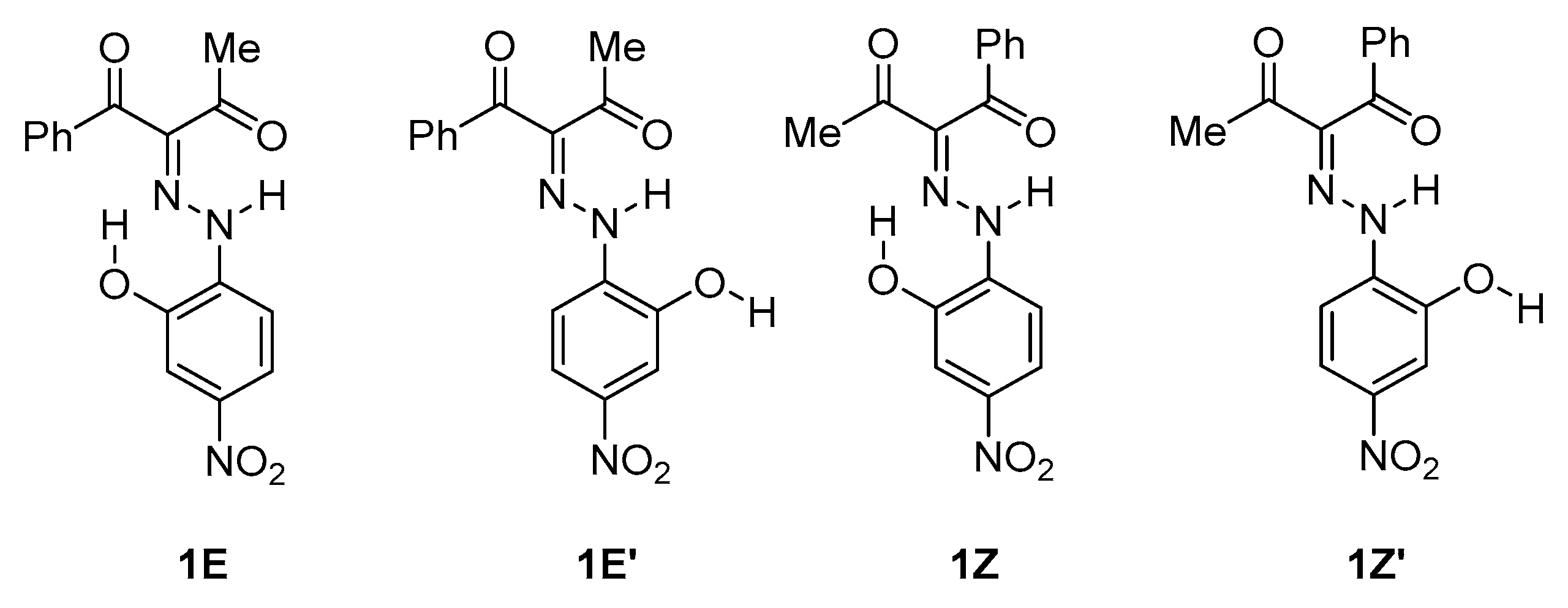

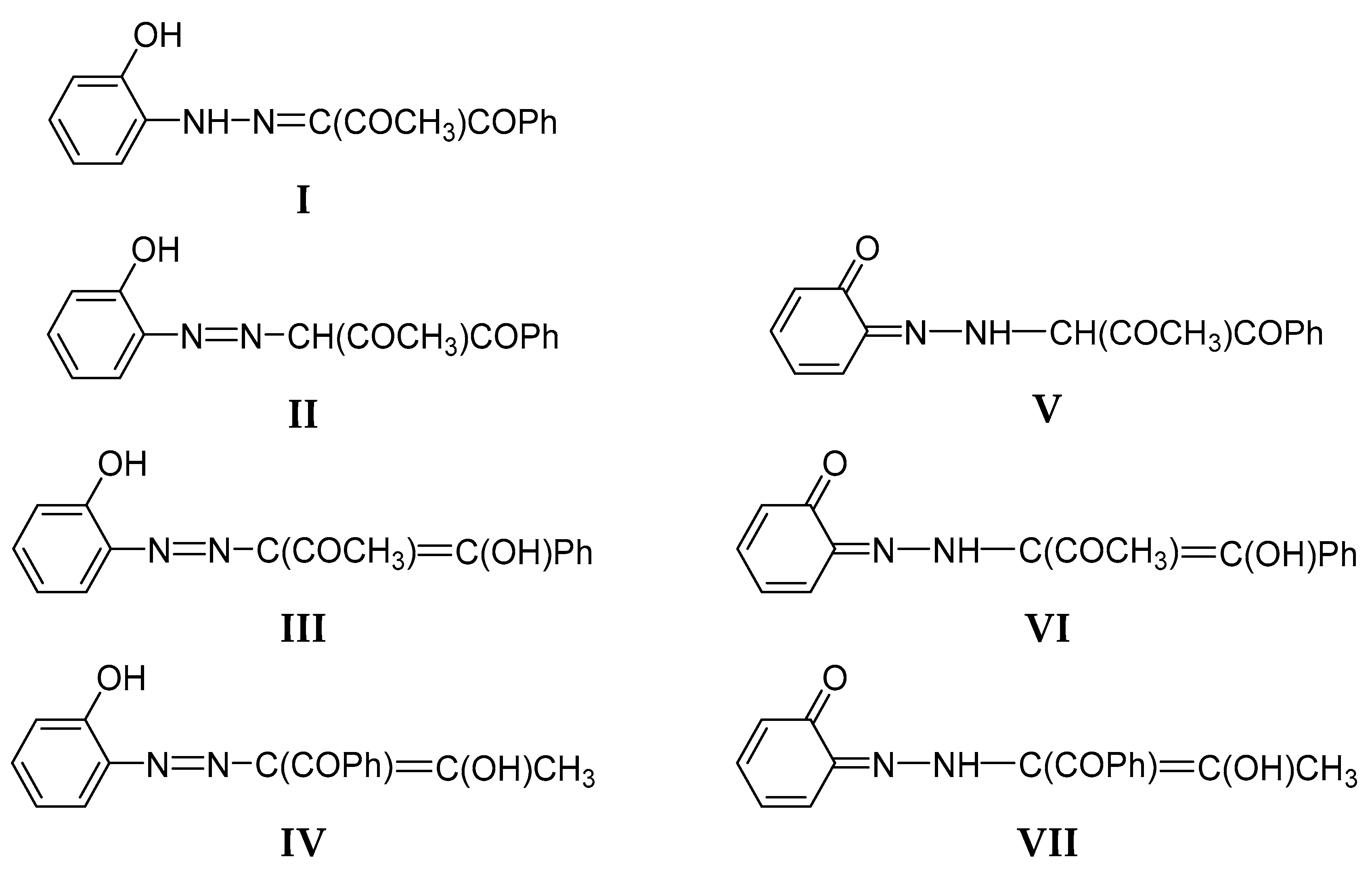

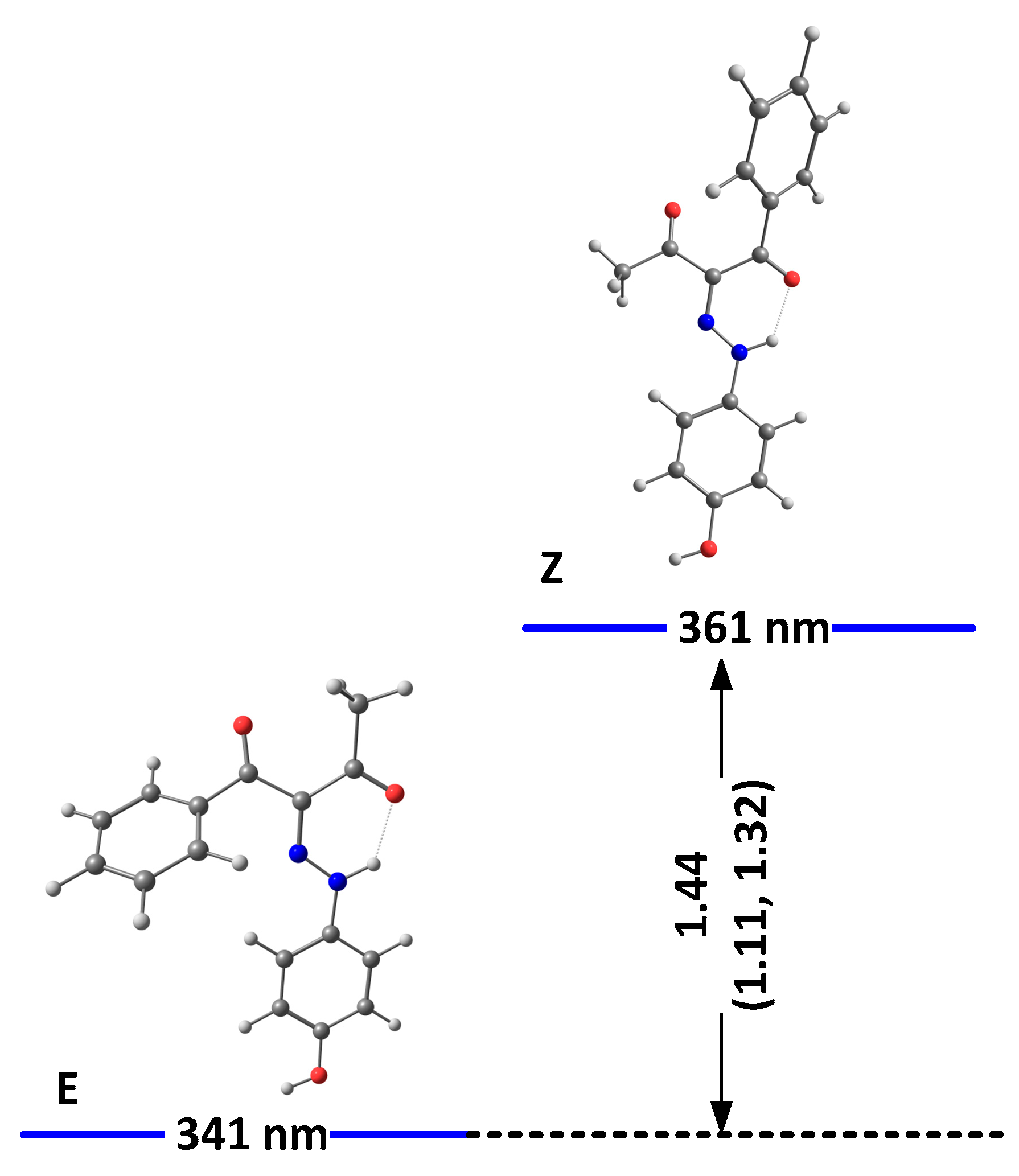
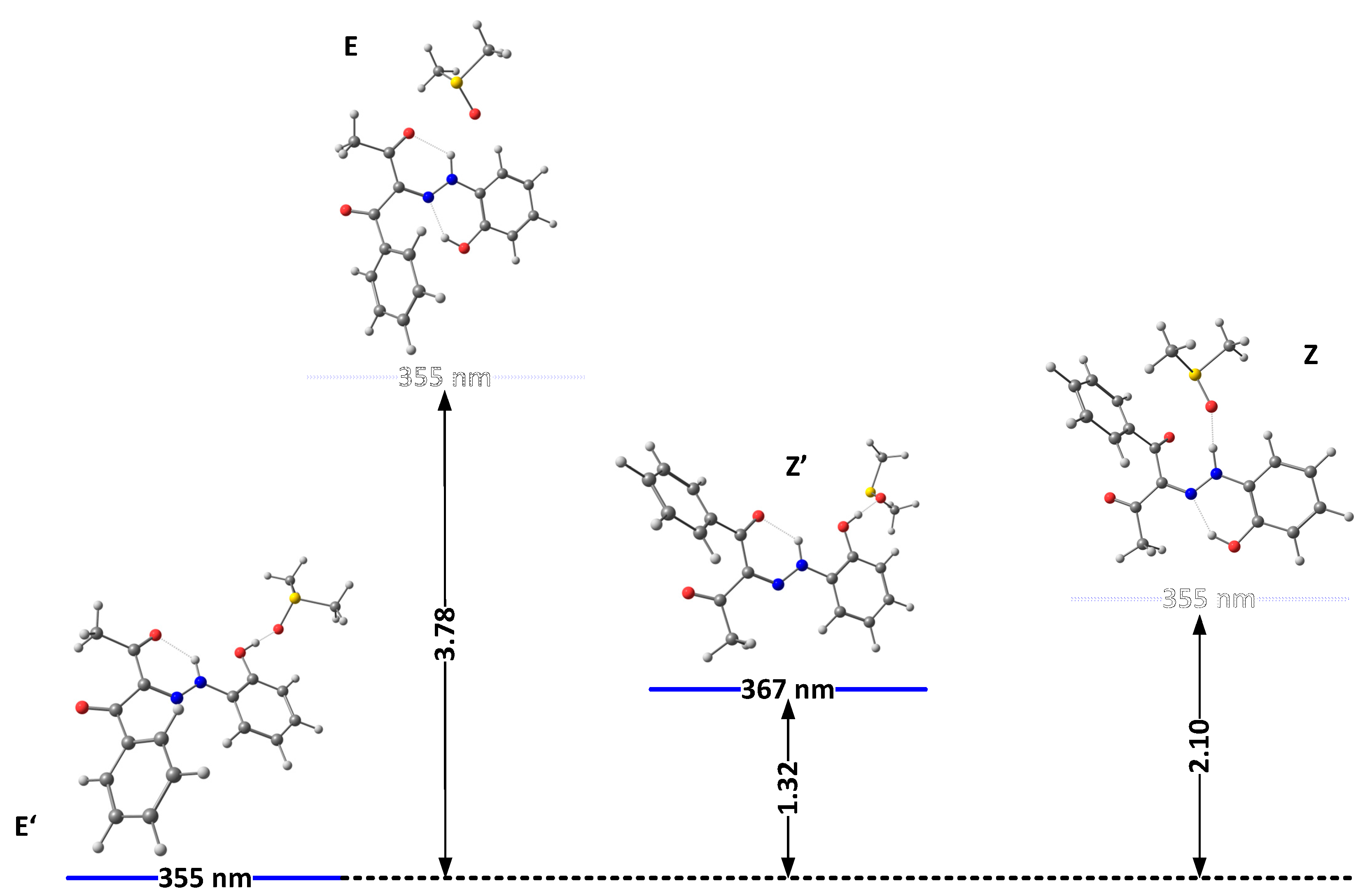
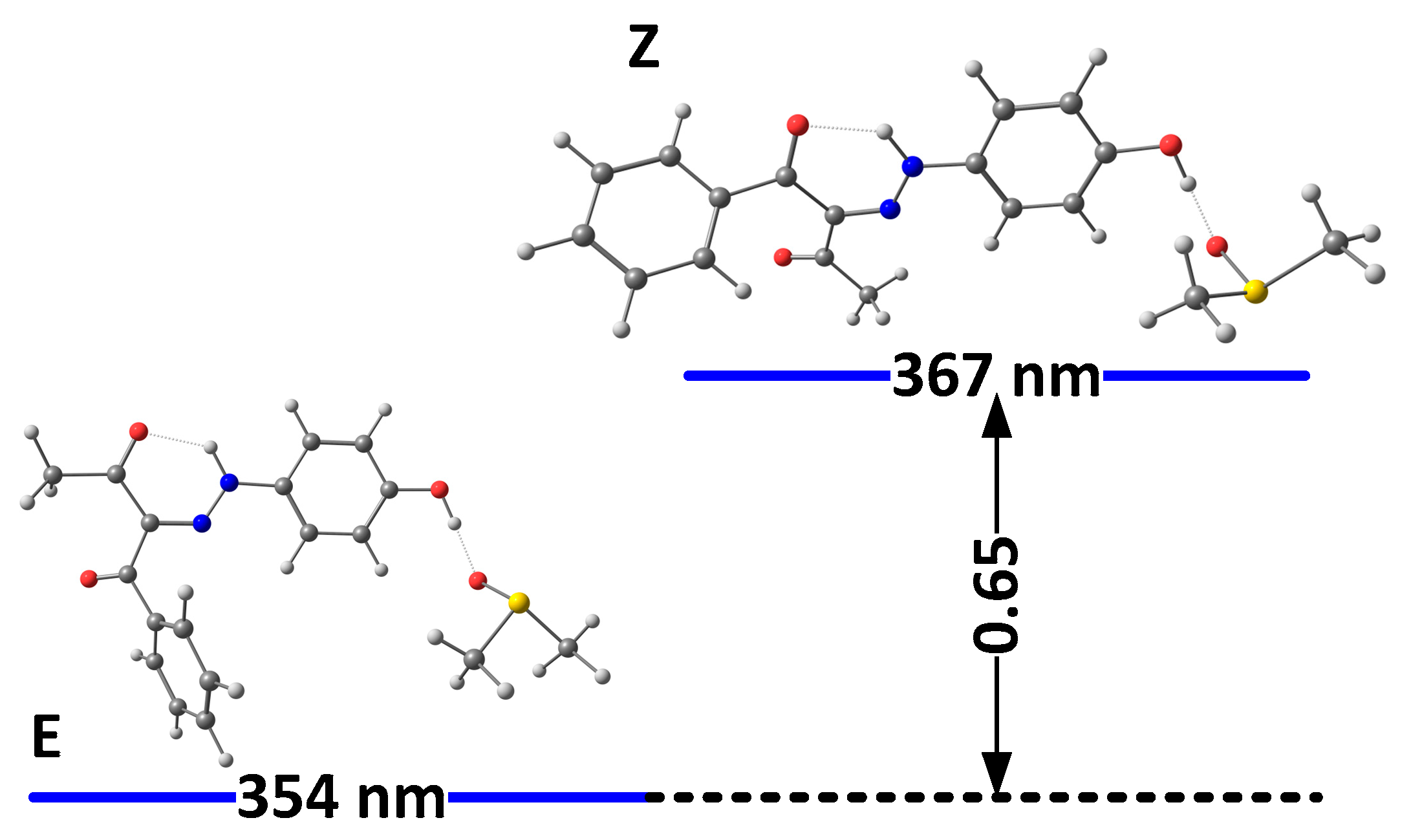
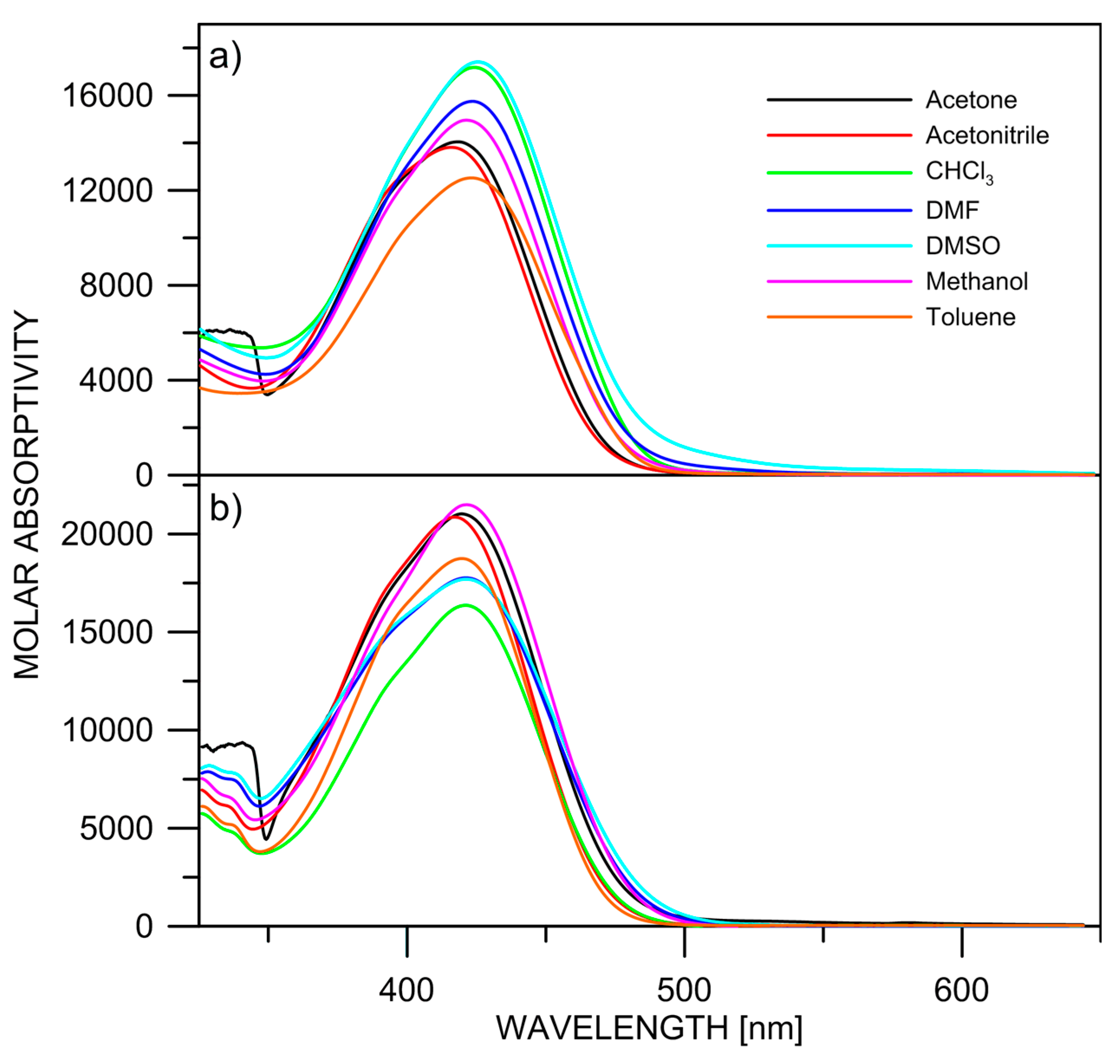
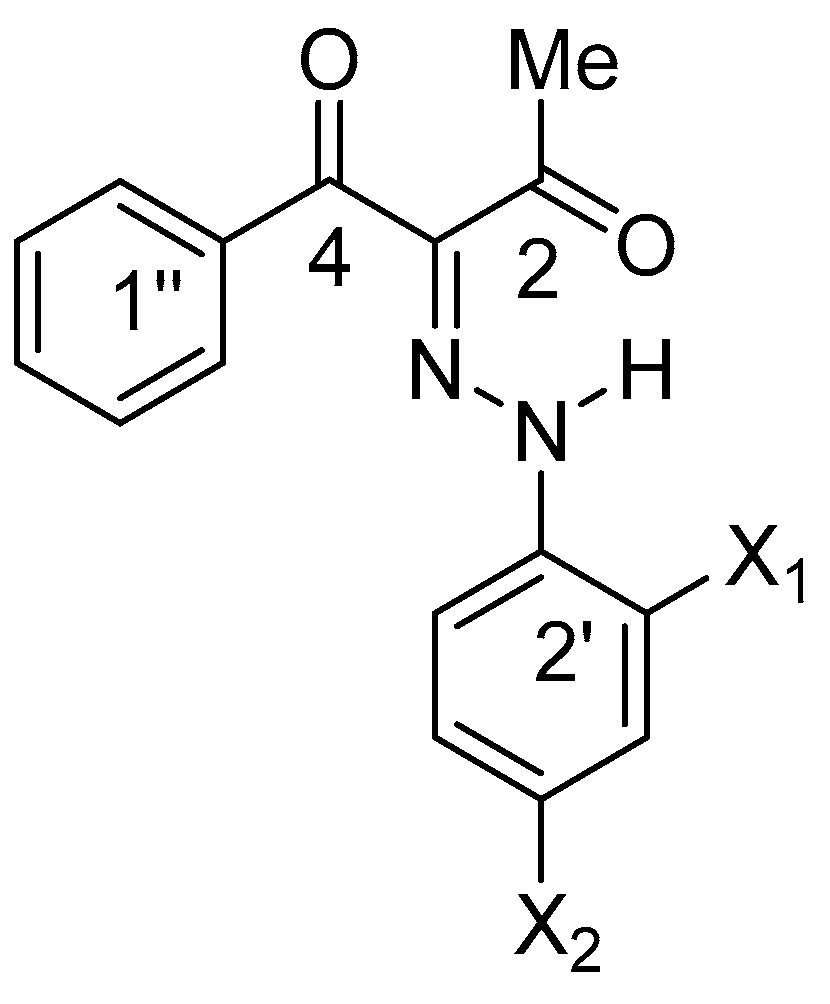
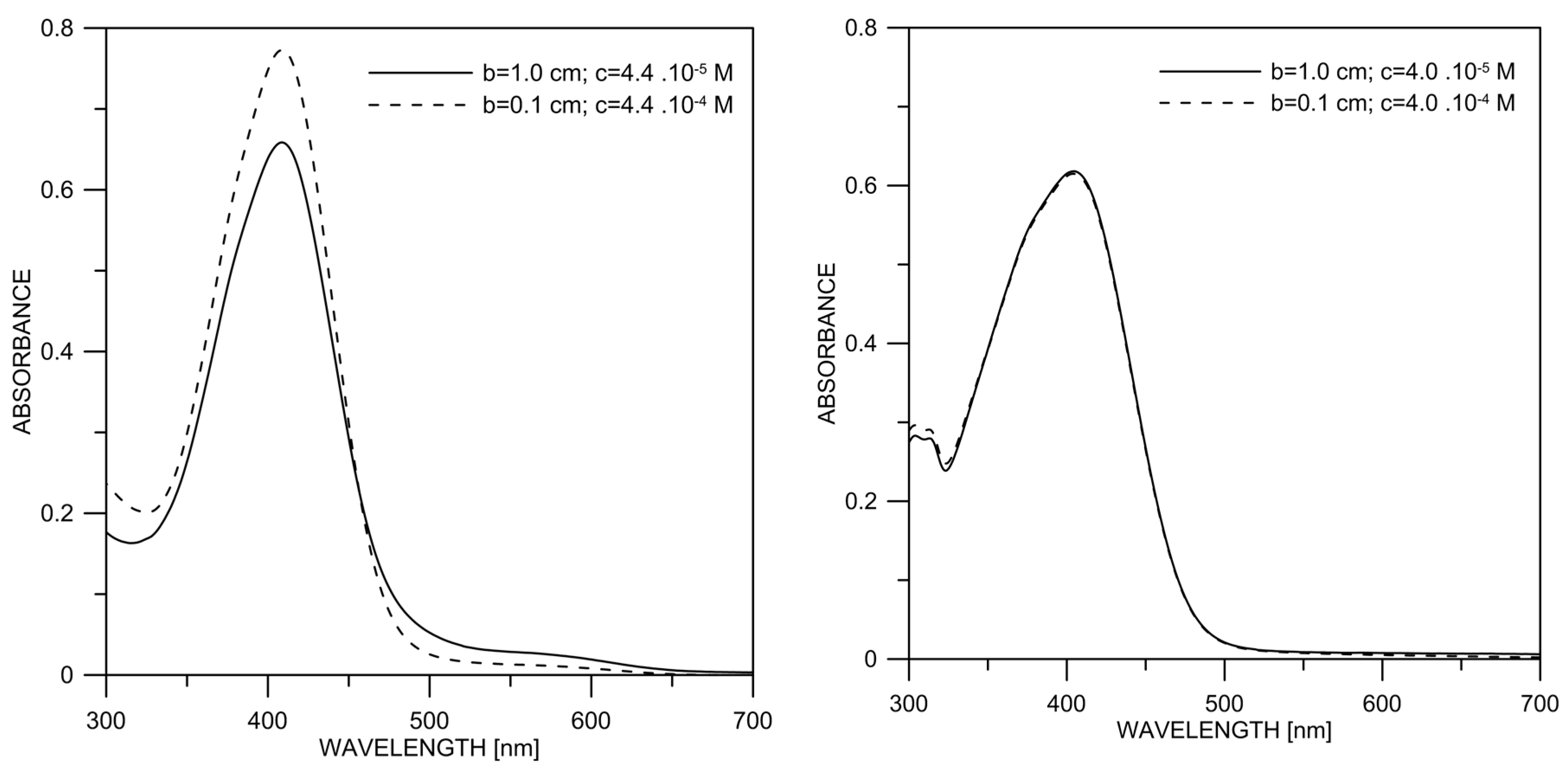
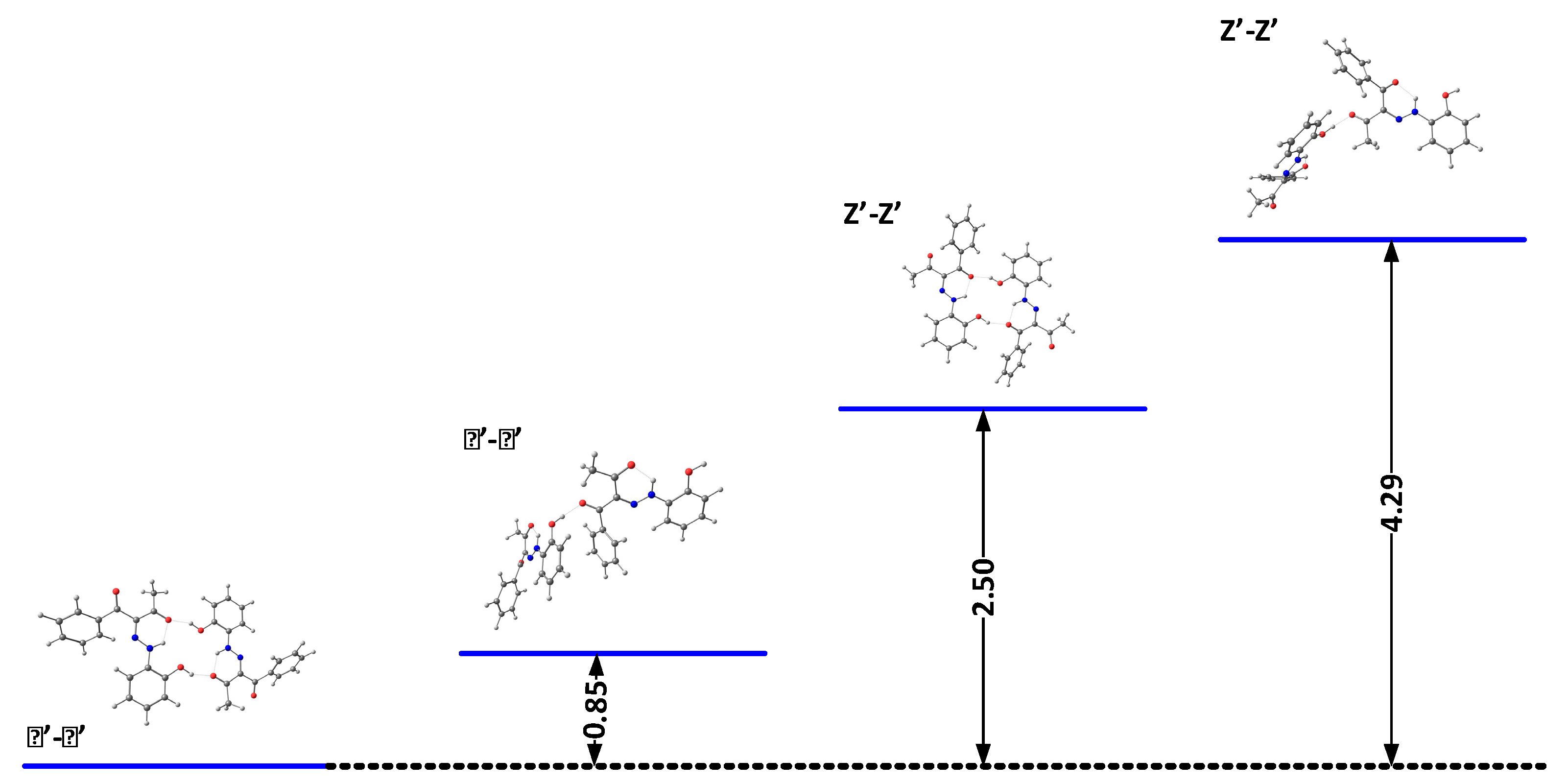
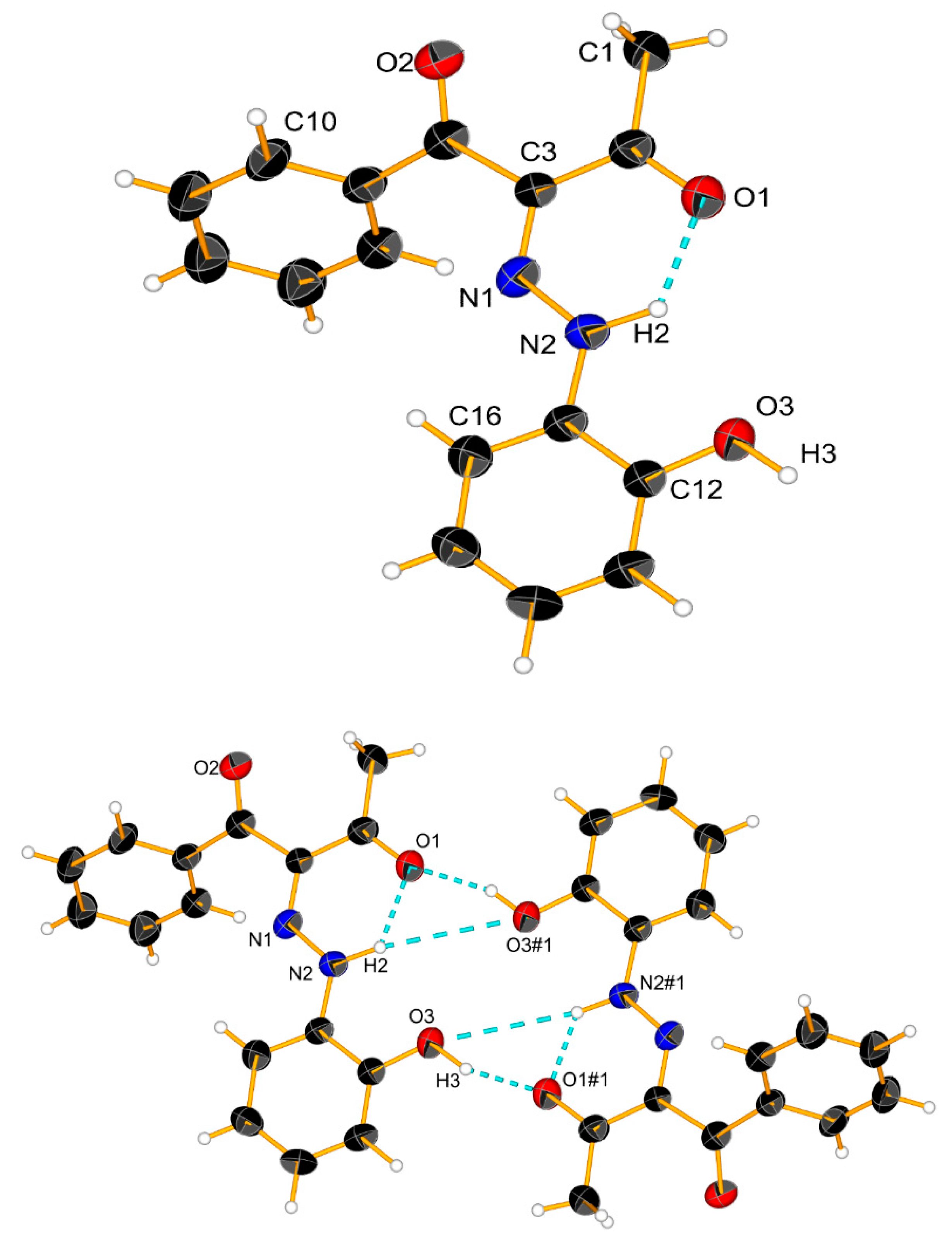
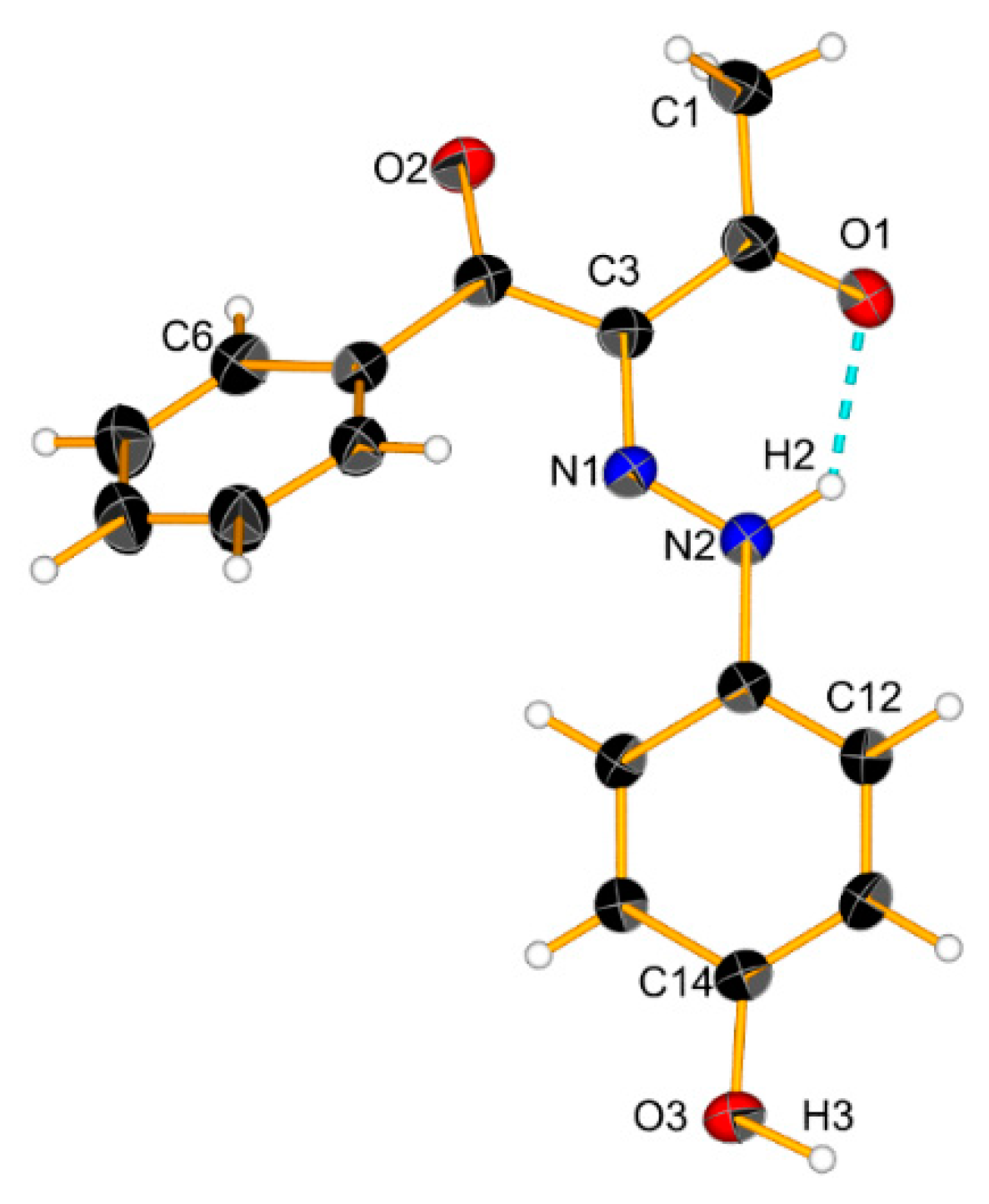


| Compound | 1 | 2 | 3 |
|---|---|---|---|
| Conformers (%) | 65/35 | 80/20 | 45/55 |
| Protons | 1H chemical shift | ||
| 1 | 2.51 (2.56) | 2.52 (a) | 2.50 (2.44) |
| 2′ | - | - | 7.16 (7.27) |
| 3′ | 7.72 (7.70) | 6.93 (ab) | 6.74 (6.76) |
| 4′ | - | 7.00 (ab) | - |
| 5′ | 7.75 (7.85) | 6.79 (ab) | 6.74 (6.76) |
| 6′ | 7.21 (7.78) | 7.09 (ab) | 7.16 (7.27) |
| 2″ | 7.91 (7.72) | 7.82 (ab) | 7.78 (7.73) |
| 3″ | 7.55 (7.51) | 7.51 (ab) | 7.50 (7.52) |
| 4″ | 7.67 (7.66) | 7.61(ab) | 7.59(7.65) |
| NH | 14.14 (11.56) d | 14.55 (12.62) | 14.46 (11.42) |
| OH | 11.56 (11.56) d | 10.56 (10.56) c | 9.58 (9.29) |
| Carbons | 13C chemical shift | ||
| 1 | 30.67 (25.92) | 30.62 (b) | 30.48 (25.31) |
| 2 | 198.08 (b) | 197.49 (b) | 197.03 (195.86) e |
| 3 | 135.66 (b) | 133.27 (b) | 134.21 (132.15) e |
| 4 | 191.95 (b) | 192.25 (b) | 194.96 (192.13) e |
| 1′ | 136.25 (b) | 139.06 (b) | 136.67 (135.54) e |
| 2′ | 145.99 (b) | 146.76 (b) | 118.31 (116.94) |
| 3′ | 110.60 (b) | 116.19 (b) | 116.50 (116.27) e |
| 4′ | 143.78 (b) | 126.38 (b) | 156.15 (154.43) e |
| 5′ | 116.78 (b) | 120.53 (b) | 116.50 (116.27) e |
| 6′ | 114.08 (b) | 114.98 (b) | 118.31 (116.94) |
| 1″ | 137.96 (b) | 133.27 (b) | 139.34 (137.06) e |
| 2″ | 130.75 (b) | 130.49 (b) | 130.32 (128.99) |
| 3″ | 128.50 (b) | 128.20 (b) | 128.16 (129.14) |
| 4″ | 133.10 (b) | 132.30 (b) | 132.05 (134.03) |
| Comp. | Type D-H…A Bond | Distances [Å] | D-H…A Angle, [°] | Ref. | |||
|---|---|---|---|---|---|---|---|
| D-H | H…A | D…A | |||||
| 1 | intramolecular | N-H…O(=C) | 0.896(9) | 1.890(7) | 2.565(1) | 130.6(7) | [24] |
| intermolecular | N-H…O(-H) | 2.266(9) | 2.619(1) | 103.1(6) | |||
| (linear dimer) | O-H…O(=C) | 0.85(2) | 1.89(2) | 2.738(1) | 176(1) | ||
| 2 | intramolecular | N-H…O(=C) | 1.03(3) | 1.79(2) | 2.567(4) | 128(1) | current work |
| intermolecular | N-H…O(-H) | 2.242(8) | 2.609(4) | 99(1) | |||
| (cyclic dimer) | O-H…O(=C) | 0.92(6) | 1.79(7) | 2.677(4) | 161(6) | ||
| 2 | intramolecular | N-H…O(=C) | 0.873 | 1.898 | 2.572(1) | 132.5 | [30] |
| intermolecular | N-H…O(-H) | 2.257 | 2.617(1) | 104.5 | |||
| (complex with water) | O-H…OH2 | 0.908 | 1.736 | 2.678 | 170.2 | ||
| 3 | intramolecular intermolecular (linear dimer) | N-H…O(=C) | 0.95(2) | 1.83(2) | 2.565(2) | 132(2) | current work |
| O-H…O(=C) | 0.93(3) | 1.75(3) | 2.667(2) | 168(2) | |||
| 4 | intramolecular | N-H…O(=C) | 0.82(2) | 1.93(2) | 2.581(2) | 135(2) | [31] |
| 6 | intramolecular | N-H…O(=C) | 0.91(2) | 1.85(2) | 2.561(2) | 133(2) | |
| N-H…O(-Me) | 2.26(2) | 2.609(2) | 102(1) | ||||
| 7 | intramolecular | N-H…O(=C) | 0.86(3) | 1.89(3) | 2.559(3) | 133(2) | |
| 8 | intramolecular | N-H…O(=C) | 0.935 | 1.866 | 2.594(2) | 132(8) | [32] |
© 2020 by the authors. Licensee MDPI, Basel, Switzerland. This article is an open access article distributed under the terms and conditions of the Creative Commons Attribution (CC BY) license (http://creativecommons.org/licenses/by/4.0/).
Share and Cite
Hristova, S.; Kamounah, F.S.; Crochet, A.; Vassilev, N.; Fromm, K.M.; Antonov, L. OH Group Effect in the Stator of β-Diketones Arylhydrazone Rotary Switches. Chemistry 2020, 2, 374-389. https://doi.org/10.3390/chemistry2020024
Hristova S, Kamounah FS, Crochet A, Vassilev N, Fromm KM, Antonov L. OH Group Effect in the Stator of β-Diketones Arylhydrazone Rotary Switches. Chemistry. 2020; 2(2):374-389. https://doi.org/10.3390/chemistry2020024
Chicago/Turabian StyleHristova, Silvia, Fadhil S. Kamounah, Aurelien Crochet, Nikolay Vassilev, Katharina M. Fromm, and Liudmil Antonov. 2020. "OH Group Effect in the Stator of β-Diketones Arylhydrazone Rotary Switches" Chemistry 2, no. 2: 374-389. https://doi.org/10.3390/chemistry2020024
APA StyleHristova, S., Kamounah, F. S., Crochet, A., Vassilev, N., Fromm, K. M., & Antonov, L. (2020). OH Group Effect in the Stator of β-Diketones Arylhydrazone Rotary Switches. Chemistry, 2(2), 374-389. https://doi.org/10.3390/chemistry2020024







